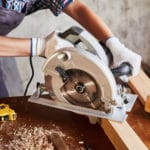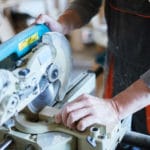Table saws are used in a variety of woodworking projects, but one common issue that arises is smoke coming from the blade. When this happens, it’s important to know what’s causing the problem and how to fix it.
In this blog post, we’ll discuss why table saw blades can emit smoke and offer some solutions for fixing them.
Is the Smoke Coming From the Blade?
One of the first things you should consider if your table saw blade is smoking is whether you’re actually seeing smoke coming from the blade.
It could be that small amounts of wood dust are rising up from the cut and obscuring your view, especially when working in a poorly ventilated area. In this case, look for an open area to work, or move your shop dust collector farther from the cut.
Is there Moisture in the Air?
Another cause of sawdust smoke is moisture in the air. When water vapor condenses on cold surfaces (like a table saw blade), it can create a light fog that will appear as smoke.
This is more common during warm weather when relative humidity levels are high. To prevent water from condensing on the blade, keep it cool by wrapping it in a poly tarp or spraying it with water.
Is it Caused by Friction?
If you’ve ruled out an optical illusion and are seeing smoke coming directly from your table saw blade, then you likely have a problem with friction. In most cases, this indicates that the wood is being pushed through the blade too quickly, causing excessive heat.
Most of the time this is caused by a worn-out or damaged blade or one that’s slightly bent.
How to Fix the Smoke?
If you think your table saw blade might be the problem, first shut off the machine and then remove it from the saw. Look down on both sides of the blade, paying special attention to the leading and trailing edges.
If you see excessive heat damage or varied beveling (where one side is higher than the other), then it’s time for a new blade.
Solution 1: Lower the Blade Speed
If your saw cuts smoothly but still makes smokey cuts, try slowing your feed rate. You can do this by lowering the blade speed or adjusting the height of your wood. If you have a dado stack installed on your saw, try cutting with the standard blade to see if it’s contributing to how much smoke is created.
Solution 2: Clean the Dust Collector Bag
If you don’t notice excessive friction when running your table saw blade through the wood, then your dust collection system could be at fault.
If you see smoke coming from your dust collection system, inspect the bag for large amounts of sawdust or wood chips (both can cause a vacuum to back up). If it looks like it’s full enough to retain water, empty it before turning the saw back on.
Excessive amounts of sawdust can cause a vacuum to back up and smoke to erupt from the table or the motor housing. If this occurs, clean out your dust collector bag often and make sure you have all the right tools for cleaning ductwork.
When working with a vacuum attached to your saw, make sure you have enough hose (or ductwork) to move the air away from you and other bystanders.
Solution 3: Clear Excess Debris Around the Blade
If there are any foreign materials on your table saw, they can disrupt its balance and cause it to smoke when used with certain woods. The only way to prevent this from happening is by cleaning off all excess debris from around the blade before you start to cut.
Check the blade for a buildup of pine sap or paint on it that is causing the problem. To fix this, use lacquer thinner to clean off the residue from your table saw so it can function properly again.
It’s important not just to make sure there are no foreign materials interfering with your table saw, but also to make sure the blade is free from any buildup that might be causing it to smoke.
Solution 4: Dirty Blade
A dirty table saw blade will create smoke because the debris on it is being ripped into small particles and heated up. To clean your blades, use a dry rag or sponge to gently wipe down the surface of the teeth from one end to another.
Be sure not to press too hard or you might remove some of the metal. You can also use a thin coat of oil for some added protection.
Solution 5: Sharpen the Blade
One solution for this problem could be as simple as keeping your blades sharp. A dull blade will lead to additional friction and heat, which can increase the amount of smoke that comes from your blade.
Never force your wood through the blade. Properly sharpened blades should cut quickly and easily, with very little effort on your part.
Keep your table saw blade clean by wiping it down after each use. When you’re working with dirty material like pine, don’t leave residue sitting on the blade for more than a day.
Make sure you’re using the correct blade for the material you cut, and that it is inserted with the bevel cutting in line with your workpiece. You can tell this by placing your hand firmly on the table (at waist height) and looking down to see if the blade tip hangs slightly below any portion of the workpiece.
Solution 6: Lubricate the Blade
Keep your blade lubricated with quality oil, like Tri-Flow TF0021060 Superior Lubricant. After applying the oil to the teeth, wipe off the excess to prevent it from getting on your workpiece. Make sure you use enough oil to cover all of the teeth; if you don’t, they will wear down prematurely.
Solution 7: Replace the Blade
If you have a dull table saw blade, it will cause more friction when cutting material and create smoke as well. The higher degree of contact between the two surfaces creates heat and eventually leads to melting or curling up of some materials.
A fresh new sharp tooth can be used to cut through these materials with ease.
Conclusion
Table saws are used in a variety of woodworking projects. One common issue that arises is smoke coming from the blade, which can be caused by many different things including dust on the blade.
If your table saw is emitting smoke from the blade, you’ll want to know what’s causing it and how to fix it. After reading this blog post, you should be able to identify the problem in no time.




